Top Ten Fluffy Animals
Just, why do we have these? So many animals, here and there, let's look at the fluffiest ones.The Top Ten
1 Cats
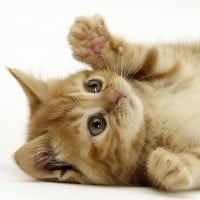

YES! SO CUTE! I have a pet cat and he is the cutest!
2 Dogs
3 Sheep
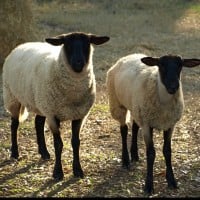 The sheep is a quadrupedal, ruminant mammal typically kept as livestock. Like all ruminants, sheep are members of the order Artiodactyla, the even-toed ungulates.
The sheep is a quadrupedal, ruminant mammal typically kept as livestock. Like all ruminants, sheep are members of the order Artiodactyla, the even-toed ungulates.
 The sheep is a quadrupedal, ruminant mammal typically kept as livestock. Like all ruminants, sheep are members of the order Artiodactyla, the even-toed ungulates.
The sheep is a quadrupedal, ruminant mammal typically kept as livestock. Like all ruminants, sheep are members of the order Artiodactyla, the even-toed ungulates.
4 Koalas
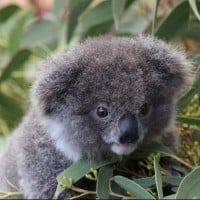 The koala is an arboreal herbivorous marsupial native to Australia. It is the only extant representative of the family Phascolarctidae and its closest living relatives are the wombats.
The koala is an arboreal herbivorous marsupial native to Australia. It is the only extant representative of the family Phascolarctidae and its closest living relatives are the wombats.
 The koala is an arboreal herbivorous marsupial native to Australia. It is the only extant representative of the family Phascolarctidae and its closest living relatives are the wombats.
The koala is an arboreal herbivorous marsupial native to Australia. It is the only extant representative of the family Phascolarctidae and its closest living relatives are the wombats.
5 Rats
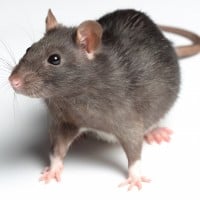 Rats are various medium-sized, long-tailed rodents of the superfamily Muroidea. "True rats" are members of the genus Rattus, the most important of which to humans are the black rat, Rattus rattus, and the brown rat, Rattus norvegicus.
Rats are various medium-sized, long-tailed rodents of the superfamily Muroidea. "True rats" are members of the genus Rattus, the most important of which to humans are the black rat, Rattus rattus, and the brown rat, Rattus norvegicus.
 Rats are various medium-sized, long-tailed rodents of the superfamily Muroidea. "True rats" are members of the genus Rattus, the most important of which to humans are the black rat, Rattus rattus, and the brown rat, Rattus norvegicus.
Rats are various medium-sized, long-tailed rodents of the superfamily Muroidea. "True rats" are members of the genus Rattus, the most important of which to humans are the black rat, Rattus rattus, and the brown rat, Rattus norvegicus.
6 Birds
7 Hedgehogs
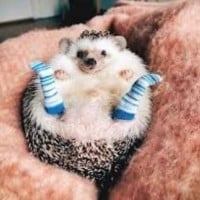 A hedgehog is any of the spiny mammals of the subfamily Erinaceinae, in the eulipotyphlan family Erinaceidae.
A hedgehog is any of the spiny mammals of the subfamily Erinaceinae, in the eulipotyphlan family Erinaceidae.
 A hedgehog is any of the spiny mammals of the subfamily Erinaceinae, in the eulipotyphlan family Erinaceidae.
A hedgehog is any of the spiny mammals of the subfamily Erinaceinae, in the eulipotyphlan family Erinaceidae. They're so fluffy I'm gonna die!
Yeah so fluffy.
8 Panda
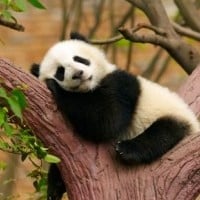 The giant panda (Ailuropoda melanoleuca), also known as the panda bear (or simply the panda), is a bear species endemic to China. ...read more.
The giant panda (Ailuropoda melanoleuca), also known as the panda bear (or simply the panda), is a bear species endemic to China. ...read more.
 The giant panda (Ailuropoda melanoleuca), also known as the panda bear (or simply the panda), is a bear species endemic to China. ...read more.
The giant panda (Ailuropoda melanoleuca), also known as the panda bear (or simply the panda), is a bear species endemic to China. ...read more.
9 Chipmunks
 Chipmunks are small, striped rodents of the family Sciuridae. Chipmunks are found in North America, with the exception of the Siberian chipmunk which is found primarily in Asia.
Chipmunks are small, striped rodents of the family Sciuridae. Chipmunks are found in North America, with the exception of the Siberian chipmunk which is found primarily in Asia.
 Chipmunks are small, striped rodents of the family Sciuridae. Chipmunks are found in North America, with the exception of the Siberian chipmunk which is found primarily in Asia.
Chipmunks are small, striped rodents of the family Sciuridae. Chipmunks are found in North America, with the exception of the Siberian chipmunk which is found primarily in Asia.
10 Porcupines
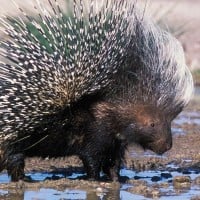 Porcupines are rodentian mammals with a coat of sharp spines, or quills, that protect against predators.
Porcupines are rodentian mammals with a coat of sharp spines, or quills, that protect against predators.
 Porcupines are rodentian mammals with a coat of sharp spines, or quills, that protect against predators.
Porcupines are rodentian mammals with a coat of sharp spines, or quills, that protect against predators.The Contenders
11 Rabbits
12 Tigers
13 Horse
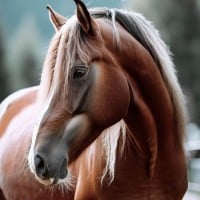 The horse is an odd-toed, hoofed mammal of the taxonomic family Equidae whose sole major subspecies (Equus ferus caballus) is a domesticate, although wild subspecies have survived into the modern period. All subspecies, including the two extant ones, descend from the Pleistocene Equus ferus. The horse has evolved over the past 45 to 55 million years from a small multi-toed creature, Eohippus, into the large, single-toed animal of today. Humans began domesticating horses around 4000 BC, and their domestication is believed to have been widespread by 3000 BC. Horses in the subspecies caballus are domesticated, although some domesticated populations live in the wild as feral horses. These feral ...read more.
The horse is an odd-toed, hoofed mammal of the taxonomic family Equidae whose sole major subspecies (Equus ferus caballus) is a domesticate, although wild subspecies have survived into the modern period. All subspecies, including the two extant ones, descend from the Pleistocene Equus ferus. The horse has evolved over the past 45 to 55 million years from a small multi-toed creature, Eohippus, into the large, single-toed animal of today. Humans began domesticating horses around 4000 BC, and their domestication is believed to have been widespread by 3000 BC. Horses in the subspecies caballus are domesticated, although some domesticated populations live in the wild as feral horses. These feral ...read more.
 The horse is an odd-toed, hoofed mammal of the taxonomic family Equidae whose sole major subspecies (Equus ferus caballus) is a domesticate, although wild subspecies have survived into the modern period. All subspecies, including the two extant ones, descend from the Pleistocene Equus ferus. The horse has evolved over the past 45 to 55 million years from a small multi-toed creature, Eohippus, into the large, single-toed animal of today. Humans began domesticating horses around 4000 BC, and their domestication is believed to have been widespread by 3000 BC. Horses in the subspecies caballus are domesticated, although some domesticated populations live in the wild as feral horses. These feral ...read more.
The horse is an odd-toed, hoofed mammal of the taxonomic family Equidae whose sole major subspecies (Equus ferus caballus) is a domesticate, although wild subspecies have survived into the modern period. All subspecies, including the two extant ones, descend from the Pleistocene Equus ferus. The horse has evolved over the past 45 to 55 million years from a small multi-toed creature, Eohippus, into the large, single-toed animal of today. Humans began domesticating horses around 4000 BC, and their domestication is believed to have been widespread by 3000 BC. Horses in the subspecies caballus are domesticated, although some domesticated populations live in the wild as feral horses. These feral ...read more.
14 Humans
 Humans (Homo sapiens) are the most abundant and widespread species of primate, characterized by bipedalism and large, complex brains. This has enabled the development of advanced tools, culture, and language. Humans are highly social and tend to live in complex social structures composed of many cooperating and competing groups, from families and kinship networks to political states. Social interactions between humans have established a wide variety of values, social norms, and rituals, which bolster human society. Curiosity and the human desire to understand and influence the environment and to explain and manipulate phenomena have motivated humanity's development of science, philosophy, mythology, ...read more.
Humans (Homo sapiens) are the most abundant and widespread species of primate, characterized by bipedalism and large, complex brains. This has enabled the development of advanced tools, culture, and language. Humans are highly social and tend to live in complex social structures composed of many cooperating and competing groups, from families and kinship networks to political states. Social interactions between humans have established a wide variety of values, social norms, and rituals, which bolster human society. Curiosity and the human desire to understand and influence the environment and to explain and manipulate phenomena have motivated humanity's development of science, philosophy, mythology, ...read more.
 Humans (Homo sapiens) are the most abundant and widespread species of primate, characterized by bipedalism and large, complex brains. This has enabled the development of advanced tools, culture, and language. Humans are highly social and tend to live in complex social structures composed of many cooperating and competing groups, from families and kinship networks to political states. Social interactions between humans have established a wide variety of values, social norms, and rituals, which bolster human society. Curiosity and the human desire to understand and influence the environment and to explain and manipulate phenomena have motivated humanity's development of science, philosophy, mythology, ...read more.
Humans (Homo sapiens) are the most abundant and widespread species of primate, characterized by bipedalism and large, complex brains. This has enabled the development of advanced tools, culture, and language. Humans are highly social and tend to live in complex social structures composed of many cooperating and competing groups, from families and kinship networks to political states. Social interactions between humans have established a wide variety of values, social norms, and rituals, which bolster human society. Curiosity and the human desire to understand and influence the environment and to explain and manipulate phenomena have motivated humanity's development of science, philosophy, mythology, ...read more.
15 Chinchilla
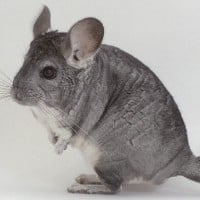 Chinchillas are two species of crepuscular rodents, slightly larger and more robust than ground squirrels. They are native to the Andes mountains in South America and live in colonies called "herds" at high elevations up to 4,270 m.
Chinchillas are two species of crepuscular rodents, slightly larger and more robust than ground squirrels. They are native to the Andes mountains in South America and live in colonies called "herds" at high elevations up to 4,270 m.
 Chinchillas are two species of crepuscular rodents, slightly larger and more robust than ground squirrels. They are native to the Andes mountains in South America and live in colonies called "herds" at high elevations up to 4,270 m.
Chinchillas are two species of crepuscular rodents, slightly larger and more robust than ground squirrels. They are native to the Andes mountains in South America and live in colonies called "herds" at high elevations up to 4,270 m.
16 Venezuelan Poodle Moth
 The Venezuelan poodle moth is a possible new species of moth discovered in 2009 by Dr. Arthur Anker of Bishkek, Kyrgyzstan, in the Gran Sabana region of Venezuela.
The Venezuelan poodle moth is a possible new species of moth discovered in 2009 by Dr. Arthur Anker of Bishkek, Kyrgyzstan, in the Gran Sabana region of Venezuela.
 The Venezuelan poodle moth is a possible new species of moth discovered in 2009 by Dr. Arthur Anker of Bishkek, Kyrgyzstan, in the Gran Sabana region of Venezuela.
The Venezuelan poodle moth is a possible new species of moth discovered in 2009 by Dr. Arthur Anker of Bishkek, Kyrgyzstan, in the Gran Sabana region of Venezuela.
17 Cattle
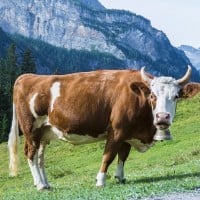 Cattle (Bos taurus) are large, domesticated, cloven-hooved, herbivores. They are a prominent modern member of the subfamily Bovinae and the most widespread species of the genus Bos. Adult females are referred to as cows and adult males are referred to as bulls. ...read more.
Cattle (Bos taurus) are large, domesticated, cloven-hooved, herbivores. They are a prominent modern member of the subfamily Bovinae and the most widespread species of the genus Bos. Adult females are referred to as cows and adult males are referred to as bulls. ...read more.
 Cattle (Bos taurus) are large, domesticated, cloven-hooved, herbivores. They are a prominent modern member of the subfamily Bovinae and the most widespread species of the genus Bos. Adult females are referred to as cows and adult males are referred to as bulls. ...read more.
Cattle (Bos taurus) are large, domesticated, cloven-hooved, herbivores. They are a prominent modern member of the subfamily Bovinae and the most widespread species of the genus Bos. Adult females are referred to as cows and adult males are referred to as bulls. ...read more.
18 Red Panda
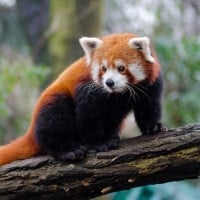 The red panda (Ailurus fulgens), or also known as the red bear-cat or the red cat-bear, is a mammal native to the Eastern Himalayas and Southwestern China. It's the only animal that belongs to the Aliuridae family. Despite having the word "panda" in its name, it's not a panda. It's closely related to raccoons, weasels, and skunks as they all belong to the musteloidea superfamily.
The red panda (Ailurus fulgens), or also known as the red bear-cat or the red cat-bear, is a mammal native to the Eastern Himalayas and Southwestern China. It's the only animal that belongs to the Aliuridae family. Despite having the word "panda" in its name, it's not a panda. It's closely related to raccoons, weasels, and skunks as they all belong to the musteloidea superfamily.
 The red panda (Ailurus fulgens), or also known as the red bear-cat or the red cat-bear, is a mammal native to the Eastern Himalayas and Southwestern China. It's the only animal that belongs to the Aliuridae family. Despite having the word "panda" in its name, it's not a panda. It's closely related to raccoons, weasels, and skunks as they all belong to the musteloidea superfamily.
The red panda (Ailurus fulgens), or also known as the red bear-cat or the red cat-bear, is a mammal native to the Eastern Himalayas and Southwestern China. It's the only animal that belongs to the Aliuridae family. Despite having the word "panda" in its name, it's not a panda. It's closely related to raccoons, weasels, and skunks as they all belong to the musteloidea superfamily.
19 Degus
 The common degu is a small caviomorph rodent endemic to the Chilean matorral ecoregion of central Chile. The name "degu" on its own indicates either the entire genus Octodon or, more likely, O. degus.
The common degu is a small caviomorph rodent endemic to the Chilean matorral ecoregion of central Chile. The name "degu" on its own indicates either the entire genus Octodon or, more likely, O. degus.
 The common degu is a small caviomorph rodent endemic to the Chilean matorral ecoregion of central Chile. The name "degu" on its own indicates either the entire genus Octodon or, more likely, O. degus.
The common degu is a small caviomorph rodent endemic to the Chilean matorral ecoregion of central Chile. The name "degu" on its own indicates either the entire genus Octodon or, more likely, O. degus.BAdd New Item